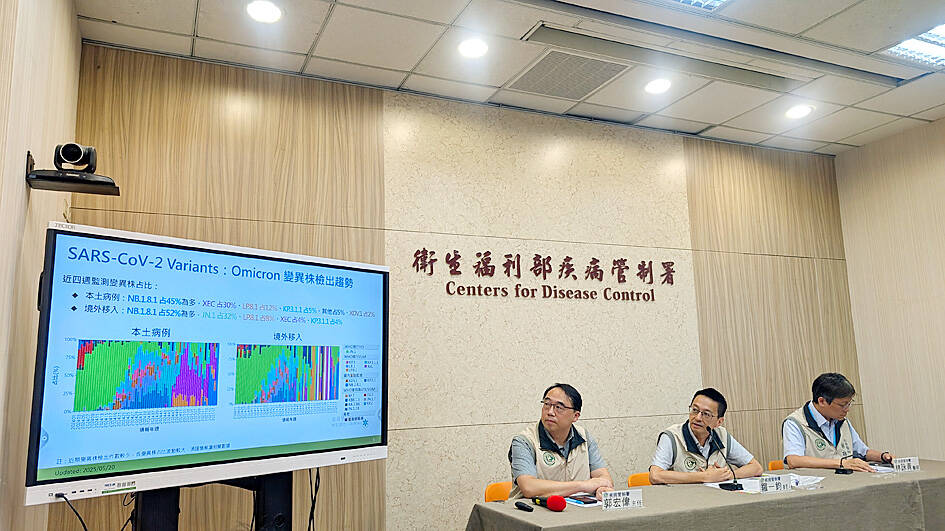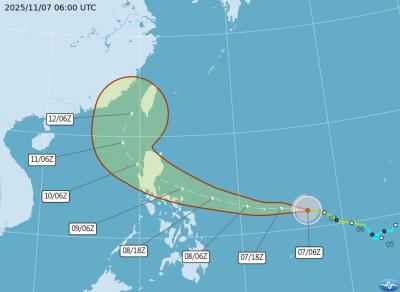Weekly hospital visits for COVID-19 surged by 88 percent last week, the Centers for Disease Control (CDC) said yesterday, adding that the NB.1.8.1 subvariant of the SARS-CoV-2 virus has become the dominant strain spreading domestically.
Hospitals reported 19,097 visits for COVID-19, as weekly cases have increased for five consecutive weeks, CDC Epidemic Intelligence Center Director Guo Hung-wei (郭宏偉) said.
Of the 93 severe COVID-19 cases confirmed last week, 88.2 percent were not vaccinated with the JN.1-adapted COVID-19 vaccine, he said, adding that four people died.

Photo: CNA
Among the 330 severe COVID-19 cases reported this year, as of Monday, 74.2 percent were people aged 65 or older, 84 percent had underlying health conditions and 90 percent did not get the JN.1-adapted vaccine, Gou said.
Virus surveillance data from the past four weeks showed that the NB.1.8.1 subvariant has become the dominant strain locally, followed by the XEC and LP.8.1 subvariants, he said.
Aside from the Americas, global test positivity rates for the SARS-CoV-2 virus have been increasing, with the LP.8.1 subvariant being reported as the dominant strain globally, he said.
The youngest severe case last week was a 10-month-old girl who did not have underlying health issues, but was also not vaccinated, CDC physician Lin Yung-ching (林詠青) said.
She first had cold-like symptoms, then developed a loss of appetite, shortness of breath and croup, Lin said.
The girl has been hospitalized in an intensive care unit for four days and is still undergoing treatment, he added.
Local COVID-19 infections are rapidly increasing, with weekly hospital visits and severe cases reaching the highest this year, CDC Deputy Director-General Philip Lo (羅一鈞) said.
“We estimate that the peak will be in mid or late June,” he said. “Estimated hospital visits during the peak period are projected to be between 55,000 and 56,000 per week.”
The estimated peak weekly visits are only about half the number of the peak period during the previous wave of infections in summer last year, but people should still not let their guard down, Lo said.
The Ministry of Health and Welfare and the CDC have also made preparations in response to the growing infections, including making sure there are enough vaccines, medication and test kits, he said.
More than 17,000 people got vaccinated against COVID-19 last week, the highest weekly number in three months, and several local health departments have reported increased vaccine demand, he said.
Although 31,000 doses have been distributed this week, the CDC plans to distribute more on Friday, he said, adding that about 3.1 million doses are available.
The CDC also secured medications, including Remdesivir, Paxlovid and Molnupiravir, for the estimated usage of between five months to a year, while it also has open-ended contracts to import more if needed, Lo said.
The Food and Drug Administration last week asked domestic manufacturers to increase production of rapid test kits for at-home and hospital use, and it also contacted the nation’s four major convenience store chains and pharmacy chains to make test kits more accessible for purchase, he said.

The Central Weather Administration (CWA) today issued a sea warning for Typhoon Fung-wong effective from 5:30pm, while local governments canceled school and work for tomorrow. A land warning is expected to be issued tomorrow morning before it is expected to make landfall on Wednesday, the agency said. Taoyuan, and well as Yilan, Hualien and Penghu counties canceled work and school for tomorrow, as well as mountainous district of Taipei and New Taipei City. For updated information on closures, please visit the Directorate-General of Personnel Administration Web site. As of 5pm today, Fung-wong was about 490km south-southwest of Oluanpi (鵝鑾鼻), Taiwan's southernmost point.

Tropical Storm Fung-Wong would likely strengthen into a typhoon later today as it continues moving westward across the Pacific before heading in Taiwan’s direction next week, the Central Weather Administration (CWA) said. As of 8am, Fung-Wong was about 2,190km east-southeast of Cape Oluanpi (鵝鑾鼻), Taiwan’s southernmost point, moving westward at 25kph and possibly accelerating to 31kph, CWA data showed. The tropical storm is currently over waters east of the Philippines and still far from Taiwan, CWA forecaster Tseng Chao-cheng (曾昭誠) said, adding that it could likely strengthen into a typhoon later in the day. It is forecast to reach the South China Sea

Almost a quarter of volunteer soldiers who signed up from 2021 to last year have sought early discharge, the Legislative Yuan’s Budget Center said in a report. The report said that 12,884 of 52,674 people who volunteered in the period had sought an early exit from the military, returning NT$895.96 million (US$28.86 million) to the government. In 2021, there was a 105.34 percent rise in the volunteer recruitment rate, but the number has steadily declined since then, missing recruitment targets, the Chinese-language United Daily News said, citing the report. In 2021, only 521 volunteers dropped out of the military, the report said, citing

Nearly 5 million people have signed up to receive the government’s NT$10,000 (US$322) universal cash handout since registration opened on Wednesday last week, with deposits expected to begin tomorrow, the Ministry of Finance said yesterday. After a staggered sign-up last week — based on the final digit of the applicant’s national ID or Alien Resident Certificate number — online registration is open to all eligible Taiwanese nationals, foreign permanent residents and spouses of Taiwanese nationals. Banks are expected to start issuing deposits from 6pm today, the ministry said. Those who completed registration by yesterday are expected to receive their NT$10,000 tomorrow, National Treasury